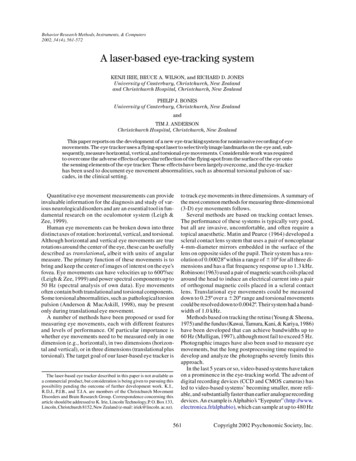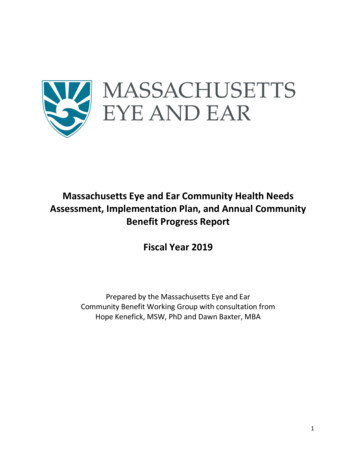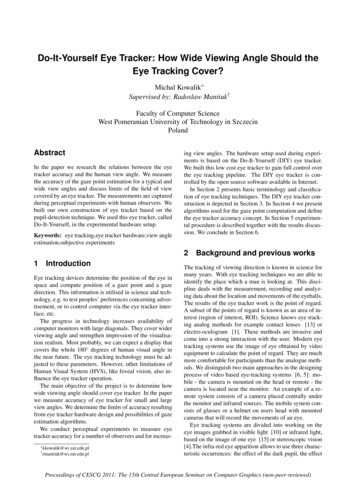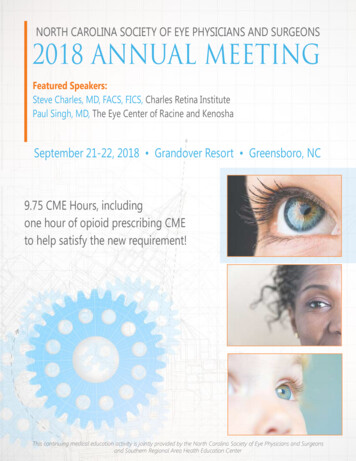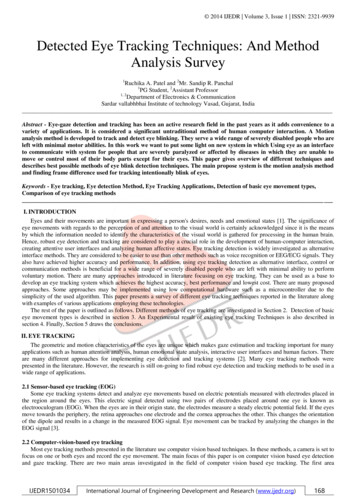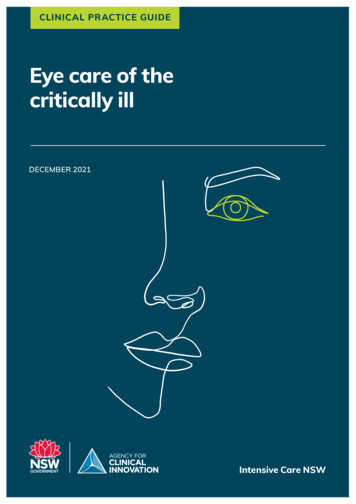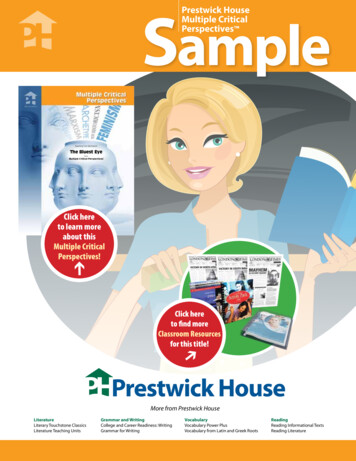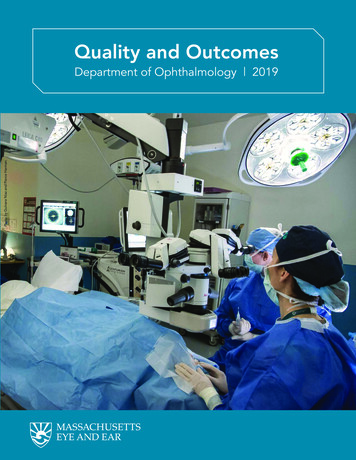
Transcription
Quality and OutcomesPhoto by Gulnara Niaz and Pierce Harman.Department of Ophthalmology 2019
Photo by Garyfallia Pagonis.Table of Contents1Letter from the President2About the Quality and Outcomes Program4Ophthalmology Clinical Leadershipin Quality 20195About Massachusetts Eye and Ear6Department of Ophthalmology Overview9Key Statistics10Emergency Department13Eye Trauma Surgery18Cataract Surgery20Retina Surgery25Glaucoma Surgery29Refractive Surgery34Cornea Surgery38Oculoplastic Surgery41Adult Strabismus Service44Neuro-Ophthalmology Service45Pediatric and Adult Strabismus Surgery50Ocular Immunology andUveitis Service51Vision Rehabilitation Service52Ophthalmology Medical Staffand Practice Locations55Contributors56Appendix
1Leading the way in making outcomes data publicly available.Dear Colleagues in Health Care,Thank you for reading the 2019 edition of the Mass. Eye and Ear Quality and OutcomesReport for the Department of Ophthalmology. This year’s book represents a specialmilestone: 10 years of consistent reporting on specific outcomes measures throughoutthe field of ophthalmology. I am very proud that Mass. Eye and Ear has led the nation indefining appropriate ophthalmology measures, collecting data, and publishing that data withcomplete transparency. I continue to hope that more organizations and providers will join us inthis effort to engage in public reporting. As you will read in the pages that follow, Mass. Eyeand Ear has enhanced its quality efforts with a renewed focus on the patient’s overall experience, an effort we expect to sustain for decades to come.This tenth edition reflects the meticulous work of many contributors, some who haveparticipated since 2010. First, we thank Dr. Joan Miller, Chief and Chair of the Departmentof Ophthalmology at Mass. Eye and Ear, Mass General, and Harvard Medical School, for herleadership in setting the national standard in ophthalmology outcomes reporting. We alsothank Dr. Alice Lorch, Chief Quality Officer for Ophthalmology, for her devotion and leadership in this project. Dr. Matthew Gardiner, Associate Director of Quality for Ophthalmologyplays a significant advisory role and we are grateful to all of the clinicians, technicians, nursesand staff members at Mass. Eye and Ear, who provide the highest quality care to our patientseach and every day.For more information on the Mass. Eye and Ear quality program and to view an electroniccopy of this report, please visit our website at MassEyeAndEar.org.John FernandezPresidentMassachusetts Eye and Ear
2Photo by Garyfallia Pagonis.About the Quality and Outcomes ProgramThis year, Mass. Eye and Ear kicked off a hospital-wide, multi-year initiative called“All About You,” intended to put the patient at the center of every decision. Theinitiative is made up of five patient experience teams each focused on one of theseareas: patient access, patient communication, clinic operations, staff engagement, andcompensation and incentives. The work on the patient experience complements our workin quality and outcomes. Together, we strive to improve the care and experience of eachand every patient.Each year, we look critically at the outcomes metrics that we have chosen for each subspecialty to ensure that they are clinically relevant. On an annual basis, we hone our methodology, moving towards automated data collection that will eventually allow us to look atthese metrics in real-time. We do all of this to identify areas in which we can improvepatient safety and quality of health care and then intervene through quality improvementprojects. This year, for example, we noticed that our rates of documented communicationof imaging results to patients in Neuro-Ophthalmology continued to decrease. We believethat patients deserve to hear their imaging results from their physician as soon as possible,ideally within 48 hours. A root cause analysis suggested that communications that aretaking place are not being captured accurately due to difficulty with a new electronicmedical record. We are working to modify the electronic medical record to more easilyallow physicians to document these crucial patient communications.
33In addition to providing longitudinal data over time for long-standing metrics, we continueto think creatively about important metrics to add to our analyses to ensure excellentpatient care. This year, we have data for the first time on SMILE refractive procedures,which we are performing with increasing frequency. Other new metrics include visual acuityfollowing treatment for open globe injuries relative to Ocular Trauma Score, and visualacuity following treatment for uveitis. In future years, we plan to continue to add metrics fornewer treatments and procedures, such as Optiwave Refractive Analysis (ORA) guidedcataract surgery seen highlighted on the cover.We strive at Mass. Eye and Ear to provide each and every patient with the highest qualitymedical care, and this publication is one of the ways that we monitor and ensure that carein the Department of Ophthalmology.We want to thank research assistants Mirjana Nordmann, PhD, Colleen Szypko, andThong Ta for their work on this year’s book. In the coming years, we are excited by theprospect of expanding this publication. We hope that you find this information useful,and we welcome your comments and feedback.Joan W. Miller, MDDavid Glendenning Cogan Professor of Ophthalmology and Chair,Department of Ophthalmology, Harvard Medical SchoolChief of Ophthalmology, Massachusetts Eye and Ear,Massachusetts General HospitalOphthalmologist-in-Chief, Brigham and Women’s HospitalAlice Lorch, MD, MPHChief Quality OfficerDepartment of OphthalmologyMassachusetts Eye and EarHarvard Medical School
Leadership4Ophthalmology Clinical Leadership in Quality: 2019Joan W. Miller, MDDavid Glendenning Cogan Professor of Ophthalmology,Chair, Department of Ophthalmology, Harvard Medical SchoolChief of Ophthalmology, Massachusetts Eye and Ear,Massachusetts General HospitalOphthalmologist-in-Chief, Brigham and Women’s HospitalDebra Rogers, MSMSenior Vice President for Ophthalmology and Ambulatory Operations,Massachusetts Eye and EarMatthew Gardiner, MDAssistant Professor of Ophthalmology, Harvard Medical SchoolAssociate Chief for Clinical Operations, Massachusetts Eye and EarAssociate Director of Quality, Ophthalmology, Massachusetts Eye and EarAlice Lorch, MD, MPHInstructor in Ophthalmology, Harvard Medical SchoolChief Quality Officer, Department of Ophthalmology,Massachusetts Eye and EarAalok Agarwala, MD, MBAAssistant Professor of Anesthesia, Harvard Medical SchoolChief Medical Officer, Massachusetts Eye and EarEileen Lowell, MM, BSN, RNVice President of Patient Care Services, Chief Nursing Officer,Massachusetts Eye and Ear
5FAbout Mass. Eye and EarAbout Massachusetts Eye and Earounded in 1824, Massachusetts Eye and Ear is a preeminent specialty,teaching, and research hospital dedicated to caring for disorders of the eyes,ears, nose, throat, head, and neck. Our dedicated staff provides primary andsubspecialty care and serves as a referral center for inpatient and outpatient medicaland surgical care.Mass. Eye and Ear is the leading authority in its specialties throughout the Northeastand is a resource globally for advances in patient care, research, and education. Asthe primary academic medical center for Harvard Ophthalmology, the hub of itsresearch and teaching facilities, Mass. Eye and Ear encourages multidisciplinary andinterdisciplinary pursuits across patient care, research, and education. Seminalcontributions to these three mission-critical areas span nearly 200 years and haveshaped the hospital’s reputation and success as a national and global center ofexcellence.Pivotal to our clinical quality efforts is the use of Partners eCare, a highly integratedhealth information system. Partners eCare is utilized by a large segment of HarvardMedical School’s network of hospitals and affiliates, facilitating quick and easycommunication amongst referring physicians and Mass. Eye and Ear’s consultingophthalmologists, otolaryngologists, and radiologists.Clinical LocationsBoston - 243 Charles St.*Boston - Longwood*BraintreeConcordDuxbury2018 Ophthalmology and Otolaryngology Hospital Statistics(January 1 – December 31, 2018)Patient VolumeEast BridgewaterHarwichMalden*MashpeeAll services at Mass. Eye and Ear locations.MedfordOutpatient Services* .523,243MiltonAmbulatory Surgery Services .31,050NewtonPlainville*Inpatient Surgical Services .974Providence*Emergency Department Services .21,091QuincyDischarges .1,150Beds .41Overall Operating Revenue . 459,742,349#*All clinic visits, Ambulatory Surgery Services, Emergency Department Services, and Discharges Includes community-based physicians#All sites, clinical and otes locations withophthalmology services.For more information, visitMassEyeAndEar.org/Locations
Dept. of Ophthalmology Overview6Massachusetts Eye and Ear Ophthalmology DepartmentAt the Mass. Eye and Ear/Harvard Department of Ophthalmology, we havenearly two centuries of experience in developing innovative approachesto treating eye disease and reducing blindness worldwide. We foundedsubspecialty training in the areas of cornea, retina, and glaucoma, and have pioneered tools and treatments for numerous diseases and conditions, ranging fromretinal detachment to age-related macular degeneration to corneal scarring. Ourpatient-centered core values focus on delivering the highest quality of care througheducation, innovation, and service excellence.We Are: The primary teaching hospital of the Harvard Medical School Department ofOphthalmology Home to Berman-Gund Laboratory for the Study of Retinal Degenerations,Howe Laboratory, and Schepens Eye Research Institute of Mass. Eye and Ear. Accelerating research and discovery through our Harvard Ophthalmology Institutes and Centers of Excellence:Academic Affiliationsand PartnersHarvard Medical SchoolMassachusetts GeneralHospitalBrigham and Women’sHospitalBoston Children’s HospitalBeth Israel DeaconessMedical CenterVA Boston Healthcare SystemVA Maine Healthcare SystemCambridge Health AllianceAravind Eye Hospital,Madurai, IndiaLV Prasad Eye Institute,Hyderabad, IndiaShanghai Eye and ENTHospital: Fudan University,Shanghai, ChinaAge-Related Macular Degeneration Center of ExcellenceCornea Center of ExcellenceDiabetic Eye Disease Center of ExcellenceGlaucoma Center of ExcellenceInfectious Disease InstituteMobility Enhancement & Vision Rehabilitation Center of ExcellenceOcular Genomics InstituteOcular Oncology Center of ExcellenceOcular Regenerative Medicine InstituteClinical AffiliationsMassachusetts General Hospital Mass. Eye and Ear clinicians provide comprehensive and subspecialty care toMass General patients in outpatient, inpatient consultation, surgical, and emergency care settings. Our 24/7 Emergency Department is a regional resource forurgent care and trauma, and our clinicians collaborate in the care of patients withocular cancers and burns. Mass. Eye and Ear’s dedicated Same-Day Service triages urgent and emergenteye concerns of Mass General patients as a more affordable and efficientalternative to Emergency Department care.
7Dept. of Ophthalmology OverviewBrigham and Women’s Hospital (BWH) and Brigham and Women’s FaulknerHospital (BWFH) Mass. Eye and Ear ophthalmologists provide comprehensive and subspecialtycare and inpatient consultations to BWH and BWFH patients, including 24/7emergency eye care and trauma coverage. BWH and BWFH patients also receive the full range of ophthalmic care, includingdedicated Same-Day Service, urgent consultation, and evaluations and surgery atMass. Eye and Ear-Longwood, staffed by Mass. Eye and Ear clinicians.Children’s Hospital Ophthalmology Foundation (CHOF) CHOF clinicians staff the comprehensive pediatric ophthalmology and adultstrabismus service at Mass. Eye and Ear and Mass General. Mass. Eye and Ear ophthalmologists provide subspecialty care in glaucoma,cornea, and pediatric retina surgery through CHOF.Ophthalmology Resources at Mass. Eye and Ear Highly skilled teams provide a full spectrum of primary and subspecialtyophthalmic care. Our dedicated eye Emergency Department is available 24/7. The de Gunzburg Retinal Imaging Suite offers state-of-the-art spectral domainoptical coherence tomography, optical coherence tomography angiography,swept source optical coherence tomography, fluorescein angiography, indocyanine green angiography, and ultrasound angiography. Our Inherited Retinal Disorders Service performs evaluations of patients referredfor diagnosis, prognosis, genetic counseling, and treatment of retinal degenerative disorders. The Ocular Melanoma Center, a premier referral center for the diagnosis andtreatment of eye tumors, draws patients from around the world. The Morse Laser Center provides advanced laser procedures using state-of-theart refractive, glaucoma, retinal, and anterior segment lasers. The Ocular Surface Imaging Center enables rapid, non-invasive corneal imaging. The David G. Cogan Laboratory of Ophthalmic Pathology provides enhanceddiagnostic services in conjunction with the Mass General SurgicalPathology Service. The Mass. Eye and Ear Infectious Disease Service tracks all cases of infectionsafter all procedures performed at Mass. Eye and Ear or at any of its affiliates. Our expanding Optometry Service provides screening and vision care in the context of ophthalmic practice. The Contact Lens Service specializes in therapeutic lens fittings, bandage contactlenses, and specialty contact lenses. The Mass. Eye and Ear Radiology Department houses a dedicated MRI/CTimaging suite.For more informationabout the Mass. Eye andEar Quality Programor the Department ofOphthalmology, pleasevisit our website atwww.MassEyeAndEar.org.
Dept. of Ophthalmology Overview8Photos by Garyfallia Pagonis. Our dedicated Social Work and Discharge PlanningDepartment provides information, counseling, andreferral services to patients and their families. The International Program helps patients with appointments, transportation, accommodations, and languagetranslation.Ophthalmology residenttraining in the Samueland Nancy Jo AltschulerOphthalmology SurgicalTraining Laboratory. The Altschuler Surgical Training Laboratory serves as a cornerstone of the surgical training program at Harvard Ophthalmology/Mass. Eye and Ear, and houses state-of-the-art surgical equipment, training machines for vitreoretinal andcataract surgery, a proctor station with a plasma screen, and other technologicalimprovements. The Howe Library, a Harvard University library, houses one of the most extensiveophthalmology research collections in the world. The library also collaborateswith institutions, including The Francis A. Countway Library of Medicine atHarvard Medical School, the National Library of Medicine, and Association ofVision Science Libraries.
9Key StatisticsMass. Eye and Ear Ophthalmology Associates Key Statistics(January 1–December 31, 2018)SubspecialtyPatient VisitsOutpatient Ophthalmology EncountersComprehensive Ophthalmology and Cataract Consultation halmic Plastic and Reconstructive Surgery .10,577Glaucoma .25,818Immunology and Uveitis .5,634Inherited Retinal Disorders .1,334Neuro-Ophthalmology .6,276Retina .46,247Vision Rehabilitation .1,202Total Outpatient Ophthalmology Visits .182,647Emergency Department VisitsTotal Ophthalmology Visits .16,077Surgical ProceduresTotal Ophthalmology Surgeries* .13,485Total Ophthalmology Laser Procedures* .3,502Refractive Procedures* .466Total Intravitreal Injections .17,277Data reported throughoutthe book for 2010, 2011,2012, 2013, 2014, 2015,2016, 2017, and 2018represent calendar years.The 2009 data represent12-month results as noted.Total Ophthalmology Procedures .34,730*Includes community-based physiciansAll benchmarks reportedreflect the most recentvalues in literature.
Emergency Department10Emergency DepartmentThe Emergency Department at Mass. Eye and Ear provides 24/7 urgent ophthalmiccare for the local community and for patients who are referred to Mass. Eye andEar from throughout the region. The department works closely with Mass GeneralEmergency Department to co-manage and coordinate care for patients withophthalmic problems.Ophthalmology Emergency VisitsThis bar graph shows the average number of ophthalmology initial encounters seen monthly by theMass. Eye and Ear Emergency Department across the last 10 calendar years.Ophthalmology Visit TimesThe average ophthalmology visit time in the Mass. Eye and Ear Emergency Department for calendar year 2018was 2.9 hours. The visit time is defined as the total time from when the patient walked into Mass. Eye and Ear’sEmergency Department to when the patient left the Emergency Department. Visit times over three standarddeviations from the raw mean were considered outliers and were excluded from the final analysis due to suspicion of poor documentation in those cases. According to the 2010 Press Ganey Emergency Department PulseReport, patients across the United States spent an average of four hours and seven minutes (4.12 hours) peremergency department visit. The Massachusetts state average visit time was 4.06 hours.For the past nine years, theaverage ophthalmology visittime in the Mass. Eye andEar Emergency Departmentwas lower than the averagenational and state visit times.*For calendar year 2016, the graphed data depicts only initial encounters.
11During calendar year 2018, there were 15,208 ophthalmic emergency initial encounters to the Mass. Eye and EarEmergency Department. Of these, 4,259 were associated with primary urgent diagnoses. The top 20 urgentdiagnoses represented 3,916 (25.7%) of the total Emergency Department initial encounters and are depictedbelow and ranked according to their frequency.The top five most frequent diagnoses include retinal detachment, corneal ulcer, corneal foreign body, iridocyclitis,and keratitis.Emergency DepartmentDistribution of Top 20 Urgent Ophthalmology Diagnoses
Emergency Department12Ophthalmology “Left Without Being Seen” (LWBS) Rate“Left without being seen” (LWBS) refers to patients who present to an emergency department but leave beforebeing seen by a physician. The Mass. Eye and Ear Emergency Department reported a LWBS rate of 1.6% (250patients for all 16,077 initial and follow-up ophthalmic emergency encounters) in calendar year 2018. Accordingto a 2009 report by the Society for Academic Emergency Medicine, the national LWBS rate is 1.7%.1 LWBS ratesvary greatly between hospitals; a review of the literature suggests a national range of 1.7% to 4.4%.1-3*Data reported for calendar year 2016 depicted only initial encounters. All other calendar years included all ophthalmic emergency visits (initial andfollow-up visits).The Mass. Eye and EarEmergency Department hasa lower LWBS rate comparedto national benchmarks.References: 1Pham JC, Ho GK, Hill PM, et al. National study of patient, visit and hospital characteristics associated with leaving an emergencydepartment without being seen: predicting LWBS. Acad Emerg Med 2009; 16(10): 949–955. 2Hsia RY, Asch SM, Weiss RE, et al. Hospital determinants of emergency department left without being seen rates. Ann Emerg Med 2011; 58(1): 24-32.e3. 3Handel DA, Fu R, Daya M, et al. The use ofscripting at triage and its impact on elopements. Acad Emerg Med 2010; 17(5): 495-500.
13Eye Trauma SurgeryEye Trauma SurgeryThe Eye Trauma Service at Mass. Eye and Ear provides high-quality and successful surgical care forpatients with open globe injuries from throughoutNew England.Postoperative left eye with a complex corneal laceration andextensive iris involvement after initial repair.Photo courtesy of Alice Lorch, MD, MPHTime to Surgical Repair for Open Globe InjuriesDuring calendar year 2018, 97 open globe injuries requiring repair presented to the Eye Trauma Service.There were an additional 11 cases where an exploration was performed and no repair was needed. Of the97 repaired injuries, 10 cases involving intraocular foreign bodies in the posterior segment were repaired bythe Retina Service, 10 dehisced penetrating keratoplasties were repaired by the Cornea Service, and one wasrepaired by the Oculoplastics Service; these were not included in the analysis. Seventy-six patients sufferedopen globe injuries that required urgent surgical repair by the Eye Trauma Service. Of these 76 patients,75 (98.7%) were taken to the operating room within 24 hours of arrival at Mass. Eye and Ear. Fifty-one ofthe 76 patients (67.1%) were taken to the operating room in under 12 hours. One patient was taken to theoperating room more than 24 hours after admission because of a delay in anesthesia clearance due to patientintoxication.The mean time from presentation at the Emergency Department to arrival in the operating room was9.08 hours (range: 2.25 to 25.97 hours).Multiple studies suggest the benefit of repairing open globe injuries within 12-24 hours after injury, inparticular for the prevention of endophthalmitis.1-2In calendar year2018, the Eye TraumaService repaired98.7% of presentingopen globe injurieswithin 24 hoursafter presentationto Mass. Eye and Ear.This rate is similarto prior years.References: 1Thompson, WS, Parver, LM, Enger, CL, et al. Infectious endophthalmitis after penetrating injuries with retained intraocular foreignbodies. Ophthalmology 1993; 100(10): 1468-1474. 2Cebulla, CM, Flynn Jr, HW. Endophthalmitis after Open Globe Injuries. Am J Ophthalmol.2009; 147(4): 567-568.
Eye Trauma Surgery14Median Postoperative VisionDuring the 2018 calendar year, 76 eyes of 76 patients had open globe repair by the Mass. Eye and Ear EyeTrauma Service. Of these 76 patients, visual acuity at presentation was recorded in 73 patients. Visual acuity was not possible in three patients due to their mental status. At the time of analysis, 40 patients had afollow-up visit between four and six months following surgery. Data from these individuals was analyzed forpreoperative and postoperative vision. During the 2018 calendar year, the median preoperative vision was“light perception,” and the median postoperative vision at a follow-up visit four to six months after repairwas 20/350.*A stricter follow-up window of at least four but no more than six months was in place for 2018.In a published retrospective review of 124 pediatricopen globe injuries managed by the Eye Trauma Serviceand/or Retina Service between February 1999 and April2009, analysis showed a median visual acuity at presentationof “hand motion” (N 123), and a final best correctedmedian visual acuity of 20/40 (N 124) at ten monthsmedian follow-up.1Reference: 1Shah AS, Andreoli MT, Andreoli CM, et al. Pediatric open-globe injuries: a large scale, retrospective review. Poster resented at the 37thAnnual Meeting of the American Association for Pediatric Ophthalmology and Strabismus, San Diego, California, USA, March 30-April 3, 2011.Abstract available in J AAPOS 2011; 15(1), e29.
15Patients that undergo open globe repair in the Mass. Eye and Ear Eye Trauma Service often do not return forfollow-up within the four to six month postoperative period in which we collect data on median visual acuityoutcomes; this can be due to factors such as geography and quick recoveries. To capture the outcomesof more cases, this analysis presents the final visual acuity for all patients with a minimum of one week offollow-up as a function of their respective ocular trauma score (OTS).Postoperative left eye following an open globeinjury and repair.OTS, a commonly used predictor in ocular trauma management, categorizes patients by the severity of open globeinjury. This score accounts for the patient’s visual acuity atpresentation and other preoperative findings, such as themechanism of the open globe injury and the presence orabsence of relative afferent pupillary defect. To calculatea patient’s score, all the raw points corresponding to thepresenting variables are added; the final sum correspondsto the OTS. A higher ocular trauma score predicts a bettervisual outcome.1Photo courtesy of Grayson Armstrong, MD, MPHVariablesRaw PointsInitial visionSum of raw 8081-91420/200-20/509092-1005 20/40100Rupture-23Endophthalmitis-17Perforating Injury-14Retinal detachment-11Afferent pupillary defect-10For design purposes, these tables have been adaptedfrom their original publication.1Reference: 1Kuhn F, Maisiak R, Mann L, et al. The Ocular Trauma Score (OTS). Ophthalmol Clin N Am 2002; 15: 163-165.Eye Trauma SurgeryFinal Visual Acuity and Ocular Trauma Score
Eye Trauma Surgery16Final Visual Acuity and Ocular Trauma ScoreDuring the 2018 calendar year, 76 patients had an open globe injury repaired by the Mass. Eye and Ear EyeTrauma Service. Of these, 70 patients who had a recorded visual acuity at presentation and at least one week offollow-up at Mass. Eye and Ear were included in the analysis. The most recent visual acuity in the one week tosix months window following surgery was recorded for each patient. Of the 37 patients that presented withextensive injuries to the globe (OTS 1 or 2), 29.7% (11/37) had a final visual acuity of 20/400 or better. Of theremaining 33 patients that presented with ocular trauma scores 3 to 5, 78.8% (26/33) had final visual acuitiesranging from 20/50 to 20/15.
17During calendar year 2018, 76 patients underwent open globe repair by the Mass. Eye and Ear Eye TraumaService. Of these 76 patients, zero (0%) developed endophthalmitis within 30 days of surgery. Similar resultswere reported since 2009.The standard Mass. Eye and Ear protocol for eye trauma (i.e. surgical repair by a dedicated trauma team and48 hours of intravenous antibiotics) is associated with post-traumatic endophthalmitis rates far below international benchmarks. A review of the literature suggests that endophthalmitis rates around the world range from2.6% to 17%. The United States National Eye Trauma Registry has reported an endophthalmitis rate of 6.9%after open globe repair.1A published study of our antibiotic protocol for open globe injuries included 675 open globe injuries treatedat Mass. Eye and Ear from January 2000 to July 2007. Intravenous vancomycin and ceftazidime were startedon admission and stopped after 48 hours for all patients. Patients were discharged on topical antibiotics,corticosteroids, and cycloplegics. Of these 675 eyes, 558 had at least 30 days of follow-up (mean, 11 months).The overall rate of endophthalmitis was 0.9% (5/558 cases).1 Based on the Mass. Eye and Ear experienceand the low percentage of cases with endophthalmitis, we recommend that institutions adopt a standardizedprotocol for treating open globe injuries and consider the use of prophylactic systemic antibiotics.1Reference: 1Andreoli CM, Andreoli MT, Kloek CE, et al. Low rate of endophthalmitis in a large series of open globe injuries. Am J Ophthalmol2009; 147(4): 601-608.Eye Trauma SurgeryRates of Endophthalmitis After Open Globe Repair
Cataract Surgery18Cataract SurgeryThe Comprehensive Ophthalmology and CataractConsultation Service at Mass. Eye and Ear providesa full spectrum of integrated patient care, includingannual and diabetic eye exams, prescriptions foreyeglasses, management of a variety of chronic eyeproblems, surgical intervention, and subspecialtyreferrals for advanced care. The most commonsurgery performed at Mass. Eye and Ear is cataractextraction with intraocular lens implantation.Preoperative photo of combined congenital and nuclear sclerotic cataract.Photo courtesy of Alice Lorch, MD, MPHAchieving Target Refraction (Spherical Equivalent)During the 2018 calendar ye
5 About Massachusetts Eye and Ear 6 Department of Ophthalmology Overview 9 Key Statistics 10 Emergency Department 13 Eye Trauma Surgery 18 Cataract Surgery 20 Retina Surgery . First, we thank Dr. Joan Miller, Chief and Chair of the Department of Ophthalmology at Mass. Eye and Ear, Mass General, and Harvard Medical School, for her

